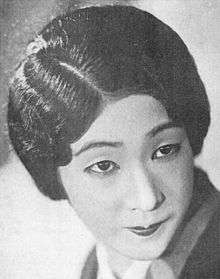Sumiko Kurishima
| Sumiko Kurishima | |
|---|---|
 Sumiko Kurishima in 1931 | |
| Native name | 栗島すみ子 |
| Born |
March 15, 1902 Tokyo, Japan |
| Died | August 16, 1987 (aged 85) |
| Other names | Kōsen Mizuki, Kakō Mizuki |
| Occupation | Actress, dancer |
| Spouse(s) | Yoshinobu Ikeda |
Sumiko Kurishima (栗島すみ子 Kurishima Sumiko) (15 March 1902 – 16 August 1987) was a Japanese actress and master of traditional Japanese dance. She is often considered Japan's first female movie star.
Career
Kurishima was the daughter of Sagoromo Kurishima, an actor and newspaper reporter.[1] Her aunt on her mother's side, Fumiko Katsuragi, was also an actress.[1] She learned traditional Japanese dance from an early age and used the name Kakō Mizuki when performing.[2] Also appearing on stage, she entered the Shōchiku studio in 1921 and debuted in Henry Kotani's adaptation of Natsume Sōseki's The Poppy.[3] Often appearing as the tragic heroine of films directed by her future husband, Yoshinobu Ikeda,[1] she is considered Japan's first popular female movie star,[4] especially considering that male onnagata played female roles in the movies up until the early 1920s. She retired from the screen in 1938 and concentrated on teaching dance, becoming the leader of her own school.[1][2] She did return to the screen in 1956, however, to appear in Mikio Naruse's Flowing.
Selected filmography
- The Poppy (虞美人草, Gubijinsō) (1921)
- Sendō kouta (船頭小唄) (1923)
- Mizumo no hana (水藻の花) (1923)
- Nageki no kujaku (嘆きの孔雀) (1924)
- Daichi wa hohoemu (大地は微笑む) (1925)
- Kanashiki koi no gensō (悲しき恋の幻想) (1925)
- What Did the Lady Forget? (淑女は何を忘れたか, Shukujo wa nani o wasureta ka) (1937)
- Flowing (流れる, Nagareru) (1956)
References
- 1 2 3 4 "Kurishima Sumiko keizu". Kingendai keizu wārudo (in Japanese). Retrieved 28 December 2010.
- 1 2 Nishigata, Setsuko. "Rekishi to genkyō" (in Japanese). Mizuki-ryū Tokyo Mizuki-kai. Retrieved 28 December 2010.
- ↑ "Kurishima Sumiko". Nihon jinmei daijiten + Plus (in Japanese). Kōdansha. Retrieved 28 December 2010.
- ↑ "Jinbutsu" (in Japanese). Matsuda Eigasha. Retrieved 28 December 2010.
External links
- Sumiko Kurishima on IMDb
- Kurishima Sumiko at the Japanese Movie Database (in Japanese)